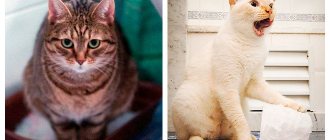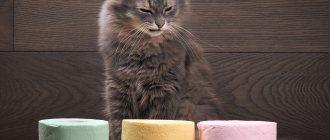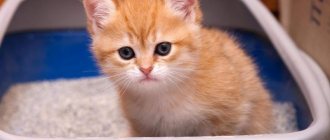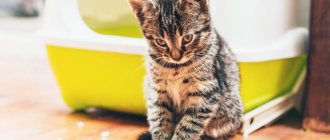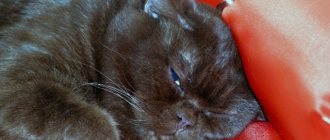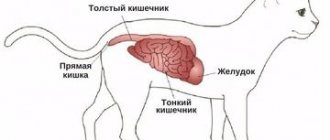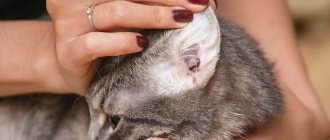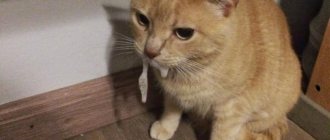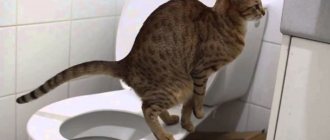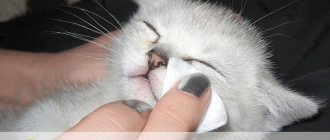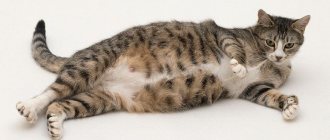Diarrhea in a cat causes concern not only for the pet itself, but also for its owner. It is easy to recognize the problem by frequent bowel movements, unusual color and consistency of feces, and a strange smell. There are many reasons for this condition; only a veterinarian can make an accurate diagnosis after examination and collection of tests.
Symptoms of diarrhea in a cat
If a cat has eaten something stale or unusual, then diarrhea may be accompanied by frequent bowel movements, flatulence, and bloating. In the case of a disease, the number of symptoms can increase to a dozen.
Signs of pathological stool disorder
In addition to soft feces, loose stools in a cat are accompanied by the following symptoms:
:
- apathetic behavior;
- vomit;
- lack of appetite;
- weight loss due to long-term disorder;
- dangerous dehydration;
- impurities of blood, mucus, undigested pieces of food;
- temperature increase;
- hard belly
Properly selected treatment will help get rid of the pathology without a trace. However, a veterinarian will be able to formulate a complete picture of the disease after receiving information about the patient’s behavior over the past few days. During the examination, the specialist will check your body temperature, feel the abdominal area, and determine the degree of dehydration. Analyzes of discharge for the presence of parasites or impurities, as well as x-rays, will help diagnose the cause of the disease with the greatest accuracy.
Duration of diarrhea in a cat
The appearance and disappearance of symptoms of pathology can go unnoticed by the owner. In an isolated case of diarrhea in a cat, there is nothing to worry about, but prolonged distress becomes an alarming sign. Doctors talk about three forms of pathology:
- Acute type, which is accompanied by painful, frequent bowel movements. The malaise lasts for several days.
- Chronic form, lasting more than 7 days and causing severe exhaustion with dehydration.
- The intermittent type is periodic in nature. It sometimes returns within 1 month.
Diarrhea in a cat, which appears due to an incorrectly selected menu, goes away quickly after changing the diet. The functioning of the gastrointestinal tract is restored, and stool returns to normal. Therapeutic nutrition involves a diet with limited food and plenty of water. Diseases of another type require great attention from the veterinarian and the owner.
Some features of the disorder in kittens
In a kitten, diarrhea may begin suddenly, due to a weak gastrointestinal tract. Children are more susceptible to attacks from viruses and bacteria than adults, and also react more strongly to stale or too fatty foods.
A kitten that has just been weaned from its mother often has bowel movements. To prevent this from happening, it is better to take the kitten from the family where it was gradually transferred to solid food. A sharp separation from mother's milk can provoke a number of diseases - and not only gastrointestinal ones.
In some cases, loose stool in a kitten signals serious diseases for which it was not vaccinated yet - panleukopenia (distemper) or leptospirosis. Here, the chances of survival depend on the speed of treatment and the baby’s immune system.
Only a veterinarian can tell you how to treat diarrhea in a kitten, since any prescription of drugs must be strictly adjusted in dose and duration of use. The main task of the owner before prescribing therapy is to replenish the lack of fluid in the baby’s body.
Digestive problems in a pregnant or lactating female
The expectant mother is more susceptible to attacks from viruses or bacteria than other individuals. Any pathogenic microorganisms that enter the body of a pregnant female cause problems in the gastrointestinal tract. New foods can also cause intolerance and intestinal reactions. Such products include beef, horse meat, soybeans, fatty fish, chicken eggs, and high-calorie dairy products.
Often, even habitual food causes frequent bowel movements in a pregnant female. You should not feed an eternally hungry expectant mother with food from the master's table. Excessive amounts of food do not have time to be digested, leaving in the form of liquid feces. This pathology can provoke a miscarriage. However, the appearance of diarrhea a couple of days before giving birth is considered normal.
The factor that provokes diarrhea in a nursing female is most often milk. Its excessive consumption in its natural form is not very beneficial for the pet. Milk should be replaced with cottage cheese, fermented baked milk, kefir or unsweetened yogurt.
Another reason for weakened intestines can be hormonal changes in the body or postpartum stress. Due to feeding, the water-salt balance is disrupted.
Other symptoms
In case of infection or disturbance of the intestinal microflora in kittens in the case of green diarrhea, the following phenomena may be observed:
- decreased activity, weakness, apathy;
- weight loss;
- when defecating, the pet may experience pain and discomfort;
- decreased appetite (up to complete refusal of food);
- temperature increase;
- increased thirst;
- dry mucous membranes;
- deterioration of coat condition.
You need to be wary of rapid development of diarrhea and high fever - this is a sign of bacterial infection, which is especially dangerous for small animals. It must be remembered that severe diarrhea leads to the loss of potassium and sodium salts. As a result of an imbalance in the body's water-salt balance, diarrhea and water loss intensify, which leads to severe dehydration.
Causes of diarrhea in a kitten or cat
A variety of factors can be responsible for the appearance of loose stools in a cat. First of all, these are various pathologies: inflammation of the gastrointestinal tract, uncontrolled use of antibiotics, intoxication, parasites, various infections. The list also includes oncology and diabetes.
Pathological causes of diarrhea in cats include diseases of internal organs not directly related to the gastrointestinal tract. These are diseases of the kidneys and liver, pancreas, and sometimes fungal infections.
In particularly dangerous cases, the cause may be a foreign body stuck in one of the intestinal sections. It usually causes severe pain in the pet. It is easy to determine soreness: you need to palpate (feel) the abdomen. If the cat is in pain in one specific place, it is necessary to urgently go to the veterinary hospital. Soreness does not always indicate a foreign body, but it is better to be on the safe side.
There are breeds that are the most picky about diet and new dishes. Devon rexes and Canadian sphinxes are considered such animals. They have a rather unstable digestive system, so stool failures occur frequently.
The cause of diarrhea in a cat is not always caused by something dangerous - there is a possibility that the following factors have a negative impact:
- change of feed;
- excess fatty foods;
- binge eating;
- stress.
In this case, you can avoid contacting a veterinarian, but stabilize your pet’s condition by returning to normal food and a gentle lifestyle. If you notice diarrhea and vomiting in a kitten or a pregnant female, in any case you need medical advice.
When does a cat have white feces: causes of the symptom
Whitish or acholic stool means that there is no bile in its structure. The breeder and veterinarian should assume pathology of the biliary tract, but whitish feces do not always indicate serious problems with the gastrointestinal tract.
Feces can change color when:
- feeding fatty foods or bones (changes in liver function);
- dehydration (feces are very dense and “crumb”);
- stressful situation;
- the constant presence of dairy products in the diet (feces become yellowish due to fermentation in the intestines).
These reasons are easily eliminated. It is enough to normalize the cat’s feeding regime and its maintenance.
Types of diarrhea in cats
Any digestive disorders require the use of drug therapy and a therapeutic diet. A veterinarian will help solve the problem by finding out the root cause. Analysis of the consistency and color of stool, as well as detection of accompanying symptoms, helps to see the full clinical picture. Therefore, it is important for the owner, if not to collect the biomaterial, then at least to remember what it looks like.
Diarrhea in a cat without complications
The disease without any complications can be caused by many factors. For example, banal overeating becomes a factor of malaise. This is easy to notice by the behavior of a mustachioed pet. He does not lose his appetite, his playful mood remains, but even an isolated incident becomes a reason for special control over the diet. You need to be wary if the feces acquire a different color and an uncharacteristic smell. Then you cannot avoid visiting the clinic.
Cat has diarrhea with water
Liquid bowel movements may be one-time in nature, but this also serves as a signal of certain ailments. Watery stool that lasts longer than one day is a reason to consult a veterinarian. Recommendations can be obtained by phone, answering the specialist’s questions in detail.
If there is no vomiting, you can help your pet at home by using boiled water at room temperature. Consuming it will help avoid dehydration, which is dangerous for your mustachioed friend. Food of any type is greatly reduced or completely removed for no more than a day until the pathology disappears. In the future, the condition is monitored, especially after feeding.
Loose stool in a cat with blood or mucus
The appearance of foul-smelling stool mixed with mucus is possible during treatment for intestinal parasites. Worms killed by drugs decompose and turn into a thick mass of greenish color. If the pet had a lot of parasites in its body, then there will also be a lot of mucous secretions in the feces.
Fecal matter combined with blood occurs due to inflammation of the colon. This disease is called colitis. For diagnosis, the veterinarian takes tests. Another cause of bloody excrement may be foreign objects blocking the passage from the intestines, a tumor, or severe poisoning.
After determining the factors behind the symptom, the veterinarian will recommend changes or adjustments to the patient's diet. It is necessary to completely exclude smoked, spicy, salty foods, sweets and flour products that are harmful at any time. Milk and fermented milk products will complicate the situation and should therefore be removed from the menu.
Recommended products are oatmeal and rice porridge with water or broth. Severe cases require the use of medications prescribed by a specialist. Special enzymes, antimicrobial agents, immunostimulants, and anti-inflammatory enemas will help restore digestive functions.
Deworming requires the use of anthelmintics. It is not difficult to free the animal’s body from parasites, but this must be done regularly, without waiting for intoxication. Regular clean drinking water, freely available to your mustachioed friend, can prevent dehydration and cleanse the intestines naturally.
The cat has diarrhea and vomiting
The combination of different symptoms indicates that the body is struggling with the negative consequences of the external environment. Pathologies may include allergic reactions to unsuitable food, poisoning, bacterial inflammation, pancreatitis, neoplasms, kidney disease, intestinal obstruction, and thyroid dysfunction. Sometimes heat or sunstroke causes a similar reaction.
A mustachioed friend may feel sick due to being fed dishes from the master's table. Human food is unhealthy because it contains many preservatives, spices and harmful additives. The organs remove harmful toxins along with feces and vomit. Prolonged diarrhea in combination with white foam should alert the owner. This is a sign of dangerous enteritis, which without timely treatment leads to death.
The veterinarian prescribes probiotics, as well as medications to normalize the pet’s condition. The absence of positive results after the measures taken gives rise to additional examination of the patient.
The cat's stool is black
The color of stool should normally be brown or light brown. Liquid black feces are called melena and indicate problems with the pet's internal organs. Non-dangerous reasons that provoke the appearance of dark stool may be:
- Iron supplements added to pet food.
- Raw meat or blood meal that your pet receives in too much quantity.
If the owner knows that the diet does not contain iron supplements and a large amount of raw meat, then we are talking about dangerous changes in the animal’s body. Additional symptoms such as vomiting, fever, and lack of appetite require urgent consultation with a veterinarian.
Dark stool indicates the presence of blood in it, therefore, all the reasons that caused the symptom are quite serious. Their list is very extensive: infestation by intestinal parasites, hemorrhagic gastroenteritis, colitis, gastritis, neoplasms in the stomach or intestines, gastric ulcers. Liquid feces of red-black color indicate dangerous bleeding in the gastrointestinal tract. Any of these diseases does not allow self-medication and requires a doctor’s prescription.
The cat has yellow diarrhea
Yellow color without an orange tint is one of the normal variants. Typically, bilirubin in bile begins to be converted into brown stercobilin. With liquid stool, bilirubin does not have time to be completely absorbed and therefore turns the excrement a pale yellow color. Bright yellow or orange stools are evidence of poor digestion of foods.
Another factor causing color changes may be jaundice. Having noticed an unusual condition, the owner should pay attention to the cat's diet in recent days. If there was too much raw fatty meat, fish, liver, and milk, then you should urgently adjust your diet. The result should be normalization of the color and density of excrement. If this does not happen, then you need to urgently contact a veterinarian.
The doctor will find out the cause of the disease. If this is overfeeding or a reaction to a new type of food, then he will recommend treatment at home. It consists of monitoring the condition of the pet. Dehydration can be fatal to a kitten very quickly, so access to clean, boiled water at room temperature is a must. Bilirubin is a very aggressive substance, so after each bowel movement it is necessary to wash the animal's anus with warm water and baby soap.
Green and white excrement
The green color of stool is the result of rotting or fermentation in the large intestine. This occurs due to rotten food particles stuck in the pet's body. Microorganisms are contained in them in large quantities, which causes intoxication and the development of poisoning. Toxic substances infect the entire body, so prolonged green liquid feces become a dangerous symptom. The veterinarian prescribes the use of droppers with an antibiotic solution to prevent the development of infection.
White color indicates the absence of bilirubin in excrement. Then light-colored feces indicate a blockage in the pathways responsible for the excretion of bile. White feces become a signal of chronic problems in the functioning of the liver. Even a single whitish diarrhea is a serious reason to contact a veterinary clinic.
How to help with diarrhea?
Only a veterinarian can prescribe specific antibiotic treatment for a kitten. But the owner himself can also help by giving the animal anti-diarrhea medications, as well as putting the kitten on a diet.
Diet
First, at home, it is recommended to completely limit the animal’s food intake. The fasting time depends on the age of the pet. An adult cat can easily withstand the absence of food for 24-40 hours, but a kitten - no more than 10-12 hours. Drinking water must always be available.
Diagnosis and treatment of diarrhea in cats
The owner should not worry too much about the symptom if the pet is vaccinated or has not had contact with homeless relatives. The main goal is to understand the root cause of the pathology and assess the health of the animal.
Establishing diagnosis
It must be understood that nutritional adjustments do not always have a positive effect on the restoration of bowel movements. Sometimes severe cases require extensive veterinary intervention.
Often your veterinarian will need additional laboratory tests.
It can be:
- Urine and blood tests. A general analysis makes it possible to identify hidden bleeding, inflammation, and the degree of dehydration. A biochemical blood test determines disturbances in the functioning of internal organs.
- Fecal samples are collected at least three times. This will identify parasites or bacterial contamination.
- Ultrasound or x-ray of the gastrointestinal tract.
- Endoscopy using a special camera that helps identify tumors, polyps, and inflammatory processes.
All studies are carried out in the clinic, where the pet must be transported in a plastic carrier with a leak-proof hard bottom. For hygienic purposes, it is recommended to use disposable diapers.
First aid without a veterinarian
If your cat's diarrhea is caused by a change in diet or a deviation from the diet, then it can be treated at home. It is advisable to consult a veterinarian by telephone. He will tell you what to do if a cat or a fairly old kitten has diarrhea.
On the first day, you should not give the sick person food, but drink plenty of fluids. Ideally, you should give your cat mineral water without carbon. If your pet refuses to drink liquid, you will have to force him to drink. To do this, use a regular syringe without a needle.
On the second day, give food based on rice water: it strengthens well. All food should be pureed.
Clean the tray with disinfectants in a timely manner. It is advisable to provide the animal with several trays to make it more comfortable for him to do his business.
Giving cats tablets or decoctions without the advice of a veterinarian is extremely undesirable - a strong side effect or allergic reaction is possible. Problems may also arise with dosage.
If a cat’s diarrhea does not go away within two days, it is necessary to show the tailed cat to a veterinarian. Otherwise, serious complications and death may result.
Medications
To restore the consistency of stool, there are a large number of medications that are suitable for suffering pets. Not all of them can be recommended by the doctor. Most of them remove the symptoms, but not the cause of the disease. How to treat diarrhea in a cat in classic cases:
- Enterofuril
– an effective drug that does not have significant side effects on the body. It allows you to save your pet from a disease that is caused by a bacterial infection or virus.
- Diarkan
– tablets that dissolve in water or are added to food. They are used until the disorder is eliminated. However, if the situation has not improved after 5 days, then the drug is changed. The product works well against infectious disorders.
- Furazolidone
– an antimicrobial medicine that prevents the development and spread of bacteria inside the body. Medicines are very effective when taken in the correct dosage.
- Bifidumbacterin
– a probiotic that restores the functions of the gastrointestinal tract and reduces the number of pathogenic viruses. This medicine is prescribed for long-term ailments and is combined with a course of antibiotics.
- Activated carbon, Smecta
– enterosorbent drugs that remove toxic substances from the intestines.
- Phthalazole
– broad-spectrum antimicrobial agent. It can even cope with salmonella. The tablets are given in crushed form, mixed with water.
- Enterosgel
– a remedy for toxins, good for poisoning, intestinal infections, after treatment for worms.
- Loperamide
– is not a medicine that removes the cause. However, it copes well with the symptoms of illness, as it strengthens. The tablets perfectly remove bacteria and toxins.
- Levomycetin
– a powerful remedy against viruses and microorganisms. Medicines have side effects such as rashes, dermatitis or flatulence. Do not use the product for pregnant or lactating individuals.
Any of the medications should be used only after consultation with a specialist. Only a doctor can correctly identify the disease that caused diarrhea and prescribe the appropriate medications.
What not to do
Until you or your veterinarian have established the exact cause of your cat’s diarrhea, you should under no circumstances begin treatment with tablets. If an animal is poisoned, it is not advisable to give drugs to slow down peristalsis: toxins will remain in the body, which will lead to bad consequences.
Another sad example: the cause of the disorder was dysbiosis, but the animal was treated with strong antibiotics. Obviously, the pet's condition will only worsen.
You cannot force feed an animal, as well as give it milk, kefir, or herbal decoctions. Only water is suitable, in some cases slightly salted, or mineral water without gases.
It is strictly forbidden to scold your pet for soiling things in the house or to show irritation - now he needs peace more than ever. Like any sick cat, a cat needs love and extra care.
What to do if a kitten has diarrhea? Here, self-medication is categorically excluded, and the small patient is obligatory and urgently examined by a veterinarian.
Types of diarrhea and preliminary diagnosis by stool color
If your cat is diarrhea, you need to pay attention to the color and structure of the stool. This will help clarify the clinical picture and make the correct diagnosis.
Any information is important to make a diagnosis
Loose stools happen:
- watery;
- Green colour;
- white;
- black;
- yellow;
- with mucus;
- with blood.
Diarrhea with water
Watery stool of normal color should not cause concern if diarrhea occurs 1-2 times. This sometimes happens due to a sudden change in diet, under stress, for example, after a trip to the veterinarian or after moving. A kitten has diarrhea with water due to the introduction of new food into the diet. Babies' intestines are weak; any changes in the menu can cause bowel upset.
Green diarrhea in a domestic cat
Feces acquire a greenish tint when pathogenic microflora develops in the intestines. Putrefactive processes can begin due to eating low-quality, spoiled food or due to dysbiosis. This is a potentially dangerous situation as harmful bacteria in the digestive tract continue to multiply and release toxins, poisoning the entire body. You need veterinarian help if diarrhea lasts more than 2 days.
Greenish stool with mucus
White diarrhea in a cat
White, loose stool in a pet is a reason to contact a veterinary clinic. Such feces indicate serious problems with the liver and gallbladder. Discoloration of stool is often caused by difficulty producing bile. Even if your cat has white diarrhea only once, you should not put off visiting the veterinarian.
Black liquid stool
The stool color is too dark if the animal eats a lot of iron-containing food - raw meat with blood, or takes iron supplements. Otherwise, black stools indicate internal bleeding. It can occur for various reasons, for example:
- as a result of a blow or fall from a height;
- due to helminthic infestation;
- with hemorrhagic gastroenteritis;
- due to a tumor in the intestine.
Yellow diarrhea
Light brown or yellowish runny stool is a common occurrence in pets. This color of feces indicates that food is poorly digested. Too bright a shade of yellow may indicate liver problems. Perhaps your pet ate something fatty or drank a lot of milk. Having discovered such a symptom, it is best to put the cat on a starvation diet for 8–12 hours and observe him. If the diarrhea does not stop, you will have to undergo tests to identify liver pathologies.
With blood or mucus
Blood in the stool is a warning sign. Sometimes the cause of this symptom is a foreign body that the pet has swallowed. As it moves through the intestines, it can damage its wall, hence the blood. Other reasons for the appearance of bloody streaks are inflammation of the intestinal mucosa, cracks inside the anus.
Mucus in stool
Diarrhea with mucus indicates infection with worms. A large amount of mucous secretion in the feces is detected after deworming.
Diarrhea and vomiting
When food or chemical poisoning occurs, cats develop diarrhea and vomiting. This condition can also be caused by an infectious disease or heat stroke. The body becomes dehydrated very quickly, so emergency assistance is needed. To replenish the fluid balance in the body, you need to water the cat or inject a glucose solution under its withers.
Diet food
If you notice your cat has loose stools, what should you do first? It is necessary not to feed the animal anything for one day. But water should be given in large quantities. It will need to be boiled and cooled to room temperature.
While the animal is experiencing problems, it is not given any types of dairy, fermented milk products, fatty meats, or starchy foods. After one day, the patient begins to be fed in small portions. The norm is reduced by half, offering the sufferer low-fat food that is easily digestible.
The therapeutic diet involves split feeding 3-4 times a day. Prescribed medications are added to food in crushed or diluted form. Foods recommended for the disorder include:
- cooked white rice;
- boiled chicken meat without skin;
- boiled egg yolk.
Moist canned food for animals, specially designed for problem cases, are well absorbed and have an effect on the patient’s body. They do not have an irritating effect on the mucous walls of the gastrointestinal tract. It is allowed to return to the usual diet only after the mustachioed friend’s health has been completely restored.
About the structure and appearance of feces
Yes, this may not seem very pleasant, but for the sake of the health and, possibly, the life of your cat, it is necessary to carefully evaluate the appearance, structure, consistency and other characteristics of the feces excreted by the animal.
The norm for cats is brown color and pasty consistency of feces. Again, normally during bowel movements they should be released in one portion. Wateriness and “goat balls” immediately indicate some kind of pathology. By the way, “balls” directly indicate a lack of water in the pet’s diet. This often happens to animals whose owners keep them exclusively on dry food. The yellow color of these pellets may be due to the characteristics of a particular food. It is urgent to show the animal to a veterinarian in the following cases:
- Greenish-yellow or yellowish-white stool with a cheesy consistency. Such symptoms indicate that food in the cat’s gastrointestinal tract is practically not digested.
- Watery, yellow and runny . It is very possible that your pet has a serious eating disorder or even an infection.
- The same yellow feces , but with mucus (especially cloudy), from which an unbearable odor - a clear indication of some kind of infectious disease of the gastrointestinal tract or a massive helminthic infestation.
- Regardless of the color of the stool , the presence of blood in it is an extremely serious sign. There are many reasons for the appearance of blood in stool. They have one thing in common - a potential danger to the health and life of the pet. If there is blood in the feces, call a veterinarian immediately.
The main reason for the appearance of yellow feces is acceleration of intestinal motility . The fact is that in the duodenum, bile is “injected” into semi-digested food masses. If digestion proceeds normally, bilirubin contained in bile gradually turns into stercobilin. It is this that, by the way, gives feces its characteristic brown color. In cases where the passage of food through the gastrointestinal tract is sharply accelerated (during infections, poisoning, due to worms, etc.), only bilirubin, which has a bright yellow color, reaches its “destination”.
What to do if your pet has diarrhea?
Cat diarrhea must be stopped as early as possible, otherwise it will have serious consequences for the health of the animal. This should be done after consulting with a veterinarian. If your cat poops frequently, she may be prescribed certain medications and a diet. Only an integrated approach to the problem will help your pet quickly become active and return to its previous lifestyle.
What medications will help your pet?
You can treat pets that are diarrhea at home. However, before this, the animal must be shown to a veterinarian. Medicines for a four-legged patient should be prescribed by a doctor. For treatment, Furazolidone for cats, Phthalazol, Levomycetin, etc. are used. The prescribed drugs must be used in strict accordance with the recommendations of the veterinarian. Information about the drugs that are commonly used to treat feline diarrhea is presented in the table:
| Drug name | Release form | Features of application |
| Furazolidone | Pills | This drug is rarely prescribed on the first day of therapy. Usually, Furazolidone is used in the absence of positive dynamics. The dosage of the product depends on the weight of the animal. The dose of Furazolidone for a large cat is no more than 1 tablet per day. Furazolidone should be mixed with food and given to the pet three times a day every 4 hours. |
| Enterofuril | Suspension | The medicine should be given to the animal 2-3 times a day every 8-12 hours. |
| Phthalazole | Pills | The drug must be administered to the cat 2-3 times a day in the mouth using a syringe without a needle. The tablet should first be crushed and mixed with water. |
| Levomycetin | Crushed 1/4 tablets of Levomycetin should be diluted with water, then poured into the cat’s mouth using a syringe without a needle. | |
| Activated carbon | Give your pet the medicine with water three times a day (at least 10 ml of liquid per tablet). | |
| Smecta | Powder | Dilute 1.5 g of the medicine with 50–60 ml of slightly warm water and give the solution to the cat. |
Diet food
When a pet has problems with bowel movements, a therapeutic diet is required to normalize the bowel movement process. Dietary nutrition for cat diarrhea should be based on the following principles:
- do not feed, but only water the animal during the first 24 hours;
- starting from the second day, give your pet food often and in small portions;
- exclude dairy, carbohydrate and starchy foods from the cat’s menu until the problem is resolved;
- during treatment, feed the cat boiled rice, chicken, and egg yolk;
- when feeding your pet with ready-made food, switch to products from the medicinal line (Proplan, Hills, Brit, Djosera, Eukanuba, etc.);
- return to your usual diet only after the digestion process has normalized.
Folk remedies for cat diarrhea
To cure cat diarrhea, in addition to therapy with veterinary drugs, you can use traditional methods. This should be done only after agreement with the veterinarian.
The owner of a sick pet must understand that improper treatment can aggravate the problem, and in some cases lead to the death of the animal. Information on how to cook at home and use products based on the use of natural ingredients is presented in the table:
| Main ingredients | Preparation | Application |
| Pomegranate peels | Pour boiling water over the raw materials. Strain the mixture steeped for 60 minutes. | Give the sick cat the remedy 3-4 times a day. |
| Chicken stomachs | Remove the walls of the stomachs, dry and grind into powder. | Add the powder to your cat's food at every feeding. |
| Oak bark, chamomile, St. John's wort, yarrow, bird cherry flowers and fruits, blueberries | Mix the components in equal parts. Pour hot water over the mixture. Strain the product infused for 1-2 hours. | Give the animal 30 ml of medicine 4 times a day. |
What might the stool of a sick animal look like?
In the tray of his pet, the owner may find feces that differ in shape:
- ointment-like;
- mushy;
- liquid;
- foamy;
- in the form of “goat peas”;
- in the form of a tape or pencil.
By smell they distinguish: sour, rancid, putrefactive.
- Feces acquire a sour smell when the absorption of fatty acids in the small intestine is disrupted or due to fermentation processes in the large intestine.
- An unpleasant odor, similar to the smell of bad oil, occurs when the secretory function of the pancreas is disrupted or when the flow of bile is disrupted.
- The smell of rotting occurs when digestion in the stomach is disrupted, dyspepsia develops with the proliferation of putrefactive microflora in the intestines. Or the cat suffers from colitis with ulcerations.
It is customary to distinguish feces by color:
- red (beetroot);
- black (tarry);
- dark brown;
- light brown;
- with a scarlet admixture (undigested blood);
- yellow;
- light yellow;
- greenish yellow;
- bleached slightly yellow, gray, gray-white.
A healthy cat can have red or beetroot feces if it has eaten beets or food colored with bright dyes. This coloring is not pathological and soon the stool acquires a normal color.
Treatment in the clinic
Important! If diarrhea does not go away within 1-2 days, then you should immediately contact a veterinarian, since the kitten’s body obviously cannot cope with the pathology on its own.
A doctor can seriously help you:
- First of all, a microscopic examination of a stool sample is carried out and cultured on nutrient media. Stool samples are taken for culture before starting antibiotics, otherwise the results of the study will be distorted.
- In case of bacterial infection, antibiotics are prescribed, which are selected based on the type of microbe.
- In case of viral infection, antiviral drugs are prescribed, which are also selected based on the strain of the virus.
- If it turns out that the cause of diarrhea is parasitic worms, anthelmintic (anthelminthic) drugs are prescribed.
- For diarrhea caused by poisoning, the toxin is determined and antidotes are applied (if available). There are cases when there is a suspicion of poisoning, but it is impossible to determine the toxin. Then symptomatic treatment is applied. Intoxication is relieved by intravenous administration of buffer compounds. A blood transfusion is prescribed, which can only be done in advanced veterinary clinics that have a blood bank.
- If the animal's general condition improves, it is prescribed a light diet for 14 days, after which the kitten is gradually returned to its normal diet.
Let's sum it up
Black feces in cats are not a disease in themselves. This is just a symptom that is typical for certain circumstances. Thus, black feces often appear in pets taking medications containing iron, cats that eat a lot of raw meat or liver, as well as in those animals that with great pleasure eat foods that stain feces, often atypical for this family.
Do not delay visiting the veterinarian if you see black feces in your cat.
However, in addition to reasons that do not in any way affect the health of cats, negative circumstances can also lead to darkening of stool, such as bleeding inside the gastrointestinal tract, provoked by a huge number of different diseases. Provided that you try to cure the cat yourself, you may kill it. Stop experimenting and go to a veterinarian who is guaranteed to provide you with professional help.
Black feces in cats: causes and treatment of the disease
Cats often have problems with the gastrointestinal tract and other organs. Every owner of a four-legged pet should know which symptoms are alarming and require close attention. Timely detection of the disease and its proper treatment under the supervision of a specialist allows you to avoid serious complications. A change in the color and consistency of the animal's stool can cause anxiety in the cat's owner. Such manifestations indicate disturbances in the functioning of internal organs. The causes of black feces in a cat can be different and indicate a minor malfunction of the body or a serious illness.
If the pet is in good health and has a healthy, balanced diet, the color of the cat's stool should be brown, and its shade varies from light to dark. The consistency of stool should be medium and compact. Changes occur due to a change in diet, new foods, diseases of the internal organs, the use of certain drugs and bleeding. Serious pathologies are accompanied by other alarming symptoms.
If the case of a change in the color of stool is isolated, and the cat’s behavior does not cause any suspicion, you can stop observing for a while. Urgent action is necessary if your pet exhibits the following symptoms:
- the presence of blood spots in the stool, they indicate internal bleeding;
- pain in the pet’s abdomen, the cat will be less mobile, will not allow itself to be touched, and slight tremors may occur;
- plaintive meowing, the pet withdraws from contact with people;
- increase in body temperature, in cats it becomes higher than 38-38.5 degrees when measured rectally;
- loose stools;
- vomiting, in severe cases with blood;
- general weakness, lethargic behavior;
- loss of appetite or complete refusal to eat.
These symptoms, together with changes in the color of stool, indicate diseases of the gastrointestinal tract. In such cases, you cannot hesitate, as internal bleeding can be fatal. It is not possible to diagnose the problem at home; an accurate diagnosis requires many studies in a hospital.
The factor contributing to this pathology most often is the presence of blood in the stool, but there may be several reasons for this. Bleeding occurs both in the stomach and in different parts of the intestines, which poses a mortal danger to the cat. This happens in the following cases, each of which requires an individual approach to treatment:
- 1. Worms very often cause this problem. They live in the pet’s intestines, attaching to its walls, thereby violating their integrity. Once in the large intestine, the blood is digested and changes the color of the animal's stool.
- 2. Gastritis or colitis of traumatic origin is an inflammatory process in the stomach or small intestine that is caused by foreign objects. This most often happens if a cat eats bird bones. When chewed, splintered pieces are obtained that easily injure the internal organs of the animal. Perforations, wounds and microcracks on the walls of organs also appear from other swallowed objects.
- 3. Peptic ulcer of the stomach, duodenum, gastritis and enterocolitis of the same type, all these diseases cause the appearance of bleeding ulcers on the walls of organs, which leads to blackening of the animal’s feces.
- 4. Tumors of the small intestine and stomach, especially malignant ones, lead to the appearance of ulcers and internal bleeding.
- 5. The hemorrhagic form of gastroenteritis leads to detachment of the epithelium of the mucous membrane of the stomach and some parts of the intestine, injuring small vessels and causing bleeding. This inflammation occurs as a result of complications from severe bacterial and viral infections; the cause may be an autoimmune disease of the animal, severe stress, disturbances in the process of blood clotting, complete intolerance to any food product, food component, or a severe allergic reaction.
First of all, it is necessary to analyze the stool for the presence of hidden traces of blood. If the result is positive, then the following studies are required to determine the exact cause of the pathology:
- blood analysis;
- Ultrasound of the abdominal area;
- blood clotting test;
- radiography;
- gastroscopy.
